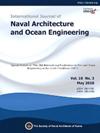以一种先进的船舶检验方法——总吨位测量三维点云为例
IF 3.9
3区 工程技术
Q2 ENGINEERING, MARINE
International Journal of Naval Architecture and Ocean Engineering
Pub Date : 2025-01-01
DOI:10.1016/j.ijnaoe.2025.100677
引用次数: 0
摘要
本研究考察了使用3D点云技术作为传统手工方法的数字替代方案的总吨位(GT)测量的可行性。24米以上的船舶遵循1969年《吨位丈量公约》(TMC)的标准化规定,而24米以下的船舶则受制于不同的国家规则,这些规则通常基于简化的公式。在这项研究中,使用激光扫描仪获取了两艘韩国船只的三维点云——一艘超过24米的政府所有船只和一艘低于24米的渔船。后处理后,采用凸包算法估算封闭体积,并与国标计算的GT值进行比较。基于点云的方法显示出最小的变化,体积的最大差异为0.30%,GT的最大差异为0.23 TON。这些结果表明,3D扫描为GT测量提供了可靠和准确的替代方案,并通过标准化的数字工作流程为更广泛的机构采用提供了潜力。本文章由计算机程序翻译,如有差异,请以英文原文为准。
A case study on the introduction of an advanced ship inspection method: Gross tonnage measurement 3D point clouds
This study examines the feasibility of gross tonnage (GT) measurement using 3D point cloud technology as a digital alternative to traditional manual methods. While ships over 24 m follow standardized regulations under the 1969 Tonnage Measurement Convention (TMC), those under 24 m are subject to diverse national rules, often based on simplified formulas. In this study, 3D point clouds were acquired using laser scanners for two Korean vessels—a government-owned ship over 24 m and a fishing vessel under 24 m. After post-processing, the enclosed volume was estimated using a convex hull algorithm and compared with GT values calculated under national standards. The point cloud-based method showed minimal variation, with a maximum difference of 0.30 % in volume and 0.23 TON in GT. These results indicate that 3D scanning provides a reliable and accurate alternative for GT measurement and offers potential for broader institutional adoption through standardized digital workflows.
求助全文
通过发布文献求助,成功后即可免费获取论文全文。
去求助
来源期刊

International Journal of Naval Architecture and Ocean Engineering
ENGINEERING, MARINE-
CiteScore
4.90
自引率
4.50%
发文量
62
审稿时长
12 months
期刊介绍:
International Journal of Naval Architecture and Ocean Engineering provides a forum for engineers and scientists from a wide range of disciplines to present and discuss various phenomena in the utilization and preservation of ocean environment. Without being limited by the traditional categorization, it is encouraged to present advanced technology development and scientific research, as long as they are aimed for more and better human engagement with ocean environment. Topics include, but not limited to: marine hydrodynamics; structural mechanics; marine propulsion system; design methodology & practice; production technology; system dynamics & control; marine equipment technology; materials science; underwater acoustics; ocean remote sensing; and information technology related to ship and marine systems; ocean energy systems; marine environmental engineering; maritime safety engineering; polar & arctic engineering; coastal & port engineering; subsea engineering; and specialized watercraft engineering.
 求助内容:
求助内容: 应助结果提醒方式:
应助结果提醒方式:


